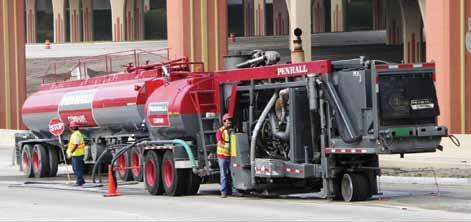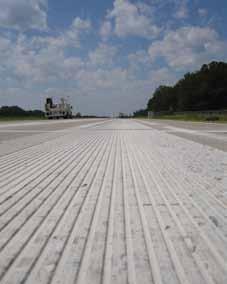
8 minute read
Pavement surface grinding techniques provide safer, smoother and quieter roads
John Roberts
Executive Director International Grooving and Grinding Association West Coxsackie, New York
Advertisement
unicipalities continue to search for the most economical and easily constructed repair techniques for their roadways. Longlasting, durable road surfaces are necessary to provide good traction, while providing a smooth and quiet ride. Concrete surface techniques in use today have increased the lifespan and effectiveness of both new and rehabilitated pavements at a very competitive cost, effectively immune to the price fluctuations in the petroleum market.
Conventional diamond grinding
Diamond grinding is an excellent procedure to repair Portland Cement Concrete (PCC) pavement roughness, increase friction and reduce tire/ pavement noise. The method uses closely spaced, diamond saw blades that gently abrade away the top surface of the concrete. The level surface is achieved by running the blade assembly at a predetermined level across the pavement surface. The uncut layer between each saw cut breaks off, leaving a level surface (at a macroscopic level) with longitudinal texture. The result is a pavement that is smooth, safe, quiet and pleasing to ride on.
Diamond grinding of concrete pavement leaves a surface which is often as good as and oftentimes better than a new pavement. In reducing the bumps and dips from the pavement surface, the dynamic loading caused by heavy wheel loads is decreased, resulting in lower stresses and less damage to the pavement. Diamond grinding reduces road noise by providing a longitudinal texture, which is quieter than transverse textures. The longitudinal texture also enhances surface macro-texture and skid resistance in polished pavements.
Conventional diamond grinding is most often used as part of a comprehensive Concrete Pavement Preservation (CPP) program, which usually includes a combination of full-depth repair, partial-depth repair, dowel bar retrofit, joint and crack resealing, slab stabilization, crossstitching of longitudinal cracks, grooving and diamond grinding. While conventional diamond grinding can be used to restore old and worn pavement to a like-new condition, it can also be utilized to address problems on new pavements such as tire/pavement noise, builtin construction roughness and inadequate surface texture. As a matter of fact, some states are now specifying conventional diamond grinding as a final surface texture on their new concrete pavements and bridge decks. Additionally there are a number of states that now require diamond grinding on new asphalt pavements that do not meet smoothness requirements.
Diamond grinding in process on a city street Diamond grinding in Iowa
In Ames, Iowa, two roads that cross through the heart of the town as well as the Iowa State University campus were in need of some welldeserved repair. With a profile index of 100 inches per mile and transverse joint faulting in excess of one inch, this pavement rode rough. A fourlane section totaling 2.56 miles was identified for repair. Although the

Two pavement surface techniques—diamond grinding and NGCS—have made our nation’s roadways safer, smoother and quieter.
City of Ames would often consider using an asphalt overlay for this type of repair, they instead opted to use concrete pavement restoration (CPR) with diamond grinding. Having learned of the success other municipalities have had with CPR, the City wanted to evaluate the life-cycle costs of each process to determine where taxpayers’ dollars are best spent. The methods selected were full-depth repair and diamond grinding followed by joint resealing.
The project began July 20, 2009 and was completed July 31, well ahead of the Aug. 17 deadline. The result for taxpayers is a safe, smooth pavement delivered in just a few weeks that is expected to last at least 15 more years. The profile index now measures 14 inches per mile, an 86 percent improvement in ride quality. With a total project cost of only $267,697, the City has realized that CPR with diamond grinding is a sustainable, cost-effective answer for their concrete pavement maintenance.
The Next Generation Concrete Surface
Quiet, safe travel has always been the goal of roadway owners and consultants alike, a fact not lost on the concrete pavement industry. Through extensive research and testing, an innovative grinding technique for concrete surfaces—the Next Generation Concrete Surface (NGCS)—now exists for even quieter travel, increased friction and improved ride.
NGCS is a diamond saw-cut surface designed to provide a consistent profile absent of positive or upward texture, resulting in a uniform land profile design with a predominantly negative texture which accounts for the very low noise characteristic of this surface type. It is a hybrid texture that resembles a combination of diamond grinding and longitudinal grooving. The texture uses diamondtipped saw blades mounted on conventional diamond grinding and grooving equipment. This texture can be used for both new construction and rehabilitation of existing surfaces and should be applied in areas where the need for tire pavement noise reduction is especially acute.
The NGCS surface was developed through a partnership with the International Grooving and Grinding Association (IGGA), American Concrete Pavement Association (ACPA), Portland Cement Association (PCA) and Purdue University. Following the Purdue research, extensive field testing and evaluation were conducted for three years by Minnesota Department of Transportation (MnDOT) at the MnROAD pavement research facility.
NGCS in Minnesota
In September 2010, MnDOT, the Concrete Paving Association of Minnesota (CPAM) and IGGA hosted a live demonstration of NGCS construction on the I-35 project site in Duluth.
This high-traffic thoroughfare in Minnesota was the first large-scale use of NGCS. Two segments of the I-35 Duluth Mega Project were involved: I-35 northbound and southbound from approximately Boundary Ave (CSAH 14) to Central Avenue and I-35 northbound and southbound from 21st Avenue East to 26th Avenue East.
“At the newest portion of I-35, right where it ends, are several hotels and they were voicing concerns about the noise. MnDOT was currently doing rehab on the road, so we decided to try this noise reducing technique. NGCS was chosen because we were looking for a grinding pattern that was quieter,” said Pat Huston, MnDOT District 1 Resident Construction Engineer.
The newly quiet highway I-35 recently made the front-page news of the local newspaper, lauding the success of the new concrete surface treatment. Even local businesses were commenting on the decreased sound level. “The response to the quieter ride has been overwhelming,” said John Roberts, Executive Director of the International Grooving and Grinding Association. “Residents have called in asking how the roads became so quiet.”
Leading the way
Two pavement surface techniques— diamond grinding and NGCS—have made our nation’s roadways safer, smoother and quieter. Research continues to find new twists on existing technology to make our roads more functional for longer timespans. As municipalities continue investing in preserving roads to increase their lifespan, these techniques have
Cold Planers



Asphalt Drum
Concrete Drum
The Asphalt Cold Planer is ideal for repairs to asphalt abutting manhole covers, curbsides, gutters and driveways. It is also used for pothole repair and utility cuts. The Trackless Series MT6 is available with a 10:1 planetary deep reduction transfer case which, when shifted into deep low, gives the operator a speed range of 0 - 10 feet/minute. Achieving creeper gear speeds any other way may be less expensive but with Trackless deep reduction, the wheelwheel torque is 10 times what it normally would be in low range. This provides smoother, surge-free asphalt or concrete milling with very precise control. Compare against all others and see the difference for yourself.





The Concrete Cold Planer has approximately three times as many picks and operates at a higher speed. The primary function of the concrete planer is to mill down sidewalk toe trips caused by frost heave and to mill wheelchair access ramps.


Snow Blowers (Standard or Ribbon) Angle Plows, V-Plows Front/Rear Salt & Sand Spreaders Flail Mowers, Boom Flail Mowers Rotary Finishing Mowers Specialty Mowers & Turf Equipment Leaf Loader with Truck Loading Chute Power Angle and Pickup Sweepers Spraying Systems Infrared Asphalt Heater & Generator Asphalt and Concrete Cold Planers Line and Stencil Painting
The close-up shows the predominantly negative texture on this Next Generation Concrete Surface.

become part of the standard toolbox used by public works officials.
About IGGA
The International Grooving and Grinding Association (IGGA) is a nonprofit trade association founded in 1972 by a group of dedicated industry professionals committed to the development of the diamond grinding and grooving process for surfaces constructed with Portland cement concrete and asphalt. In 1995, the IGGA joined in affiliation with the American Concrete Pavement Association (ACPA) to represent its newly formed Concrete Pavement Restoration Division. The IGGA/ ACPA CPR Division now serves as the technical resource and industry representative in the marketing of optimized pavement surfaces, concrete pavement restoration and pavement preservation around the world. The mission of IGGA is to serve as the leading promotional and technical resource for acceptance and proper use of diamond grinding and grooving as well as Concrete Pavement Preservation (CPP) and restoration. For more information, visit www.igga.net.
John Roberts can be reached at (518) 731-7450 or jroberts@pavement.com.










